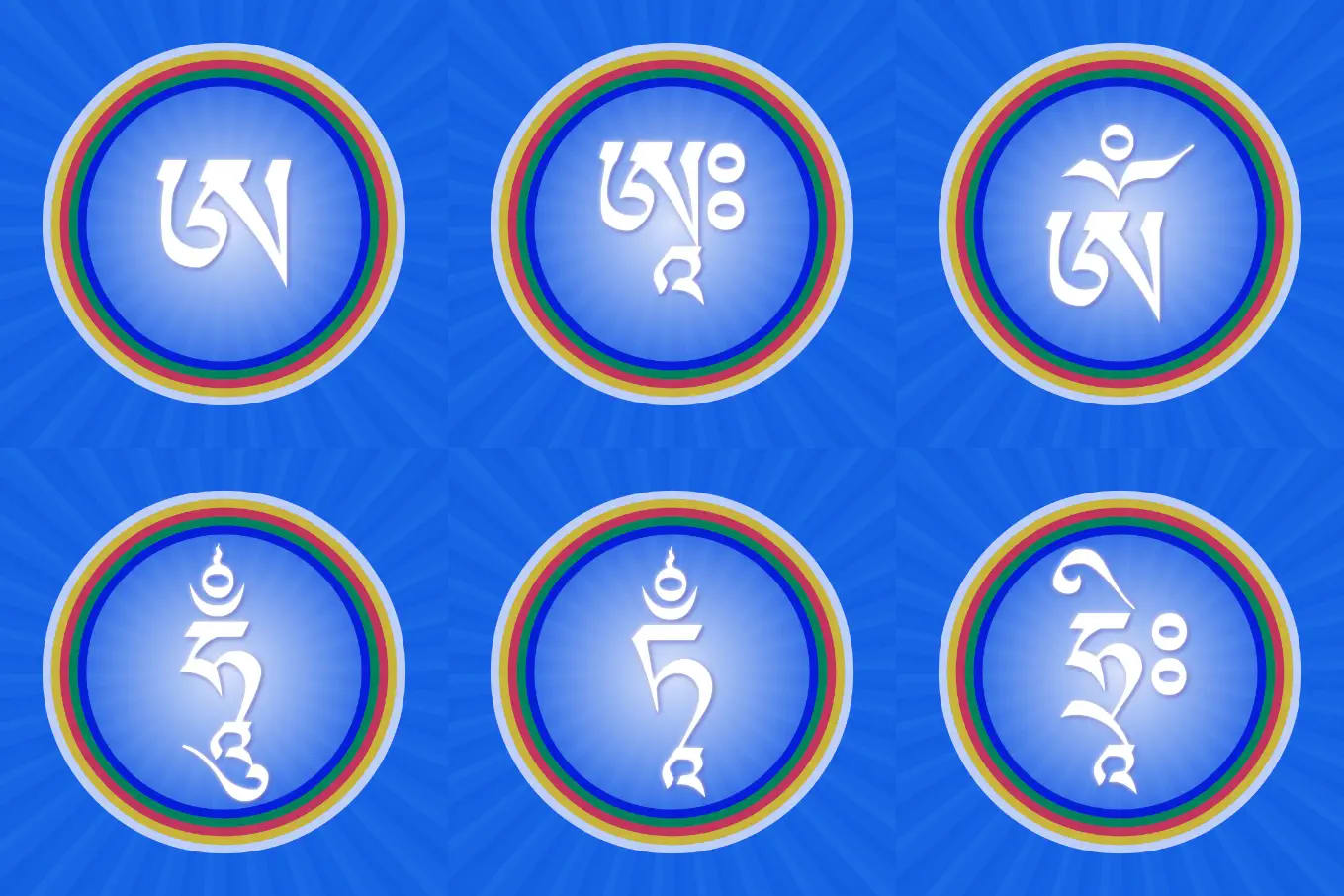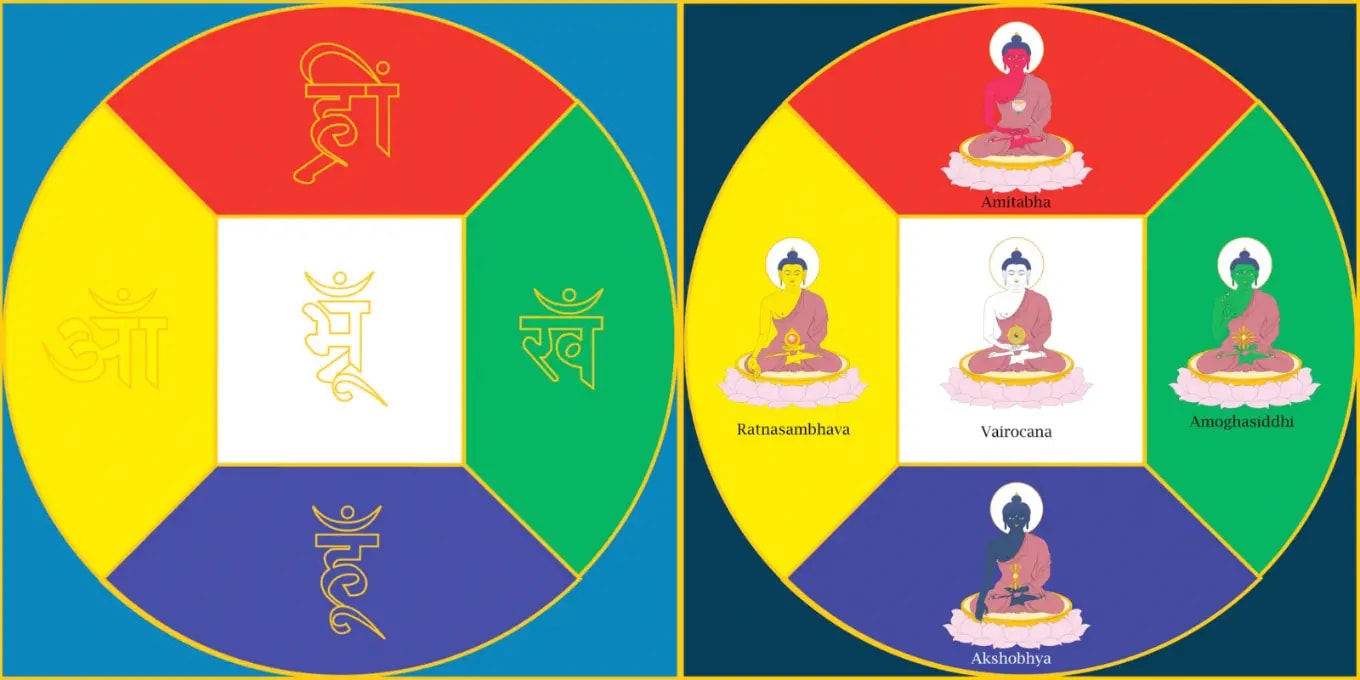These images have been created for the benefit of all beings, may they assist you in your visualization, meditation, and practice.
Where relevant, translated words are shown with their corresponding Sanskrit (skrt) and Tibetan (tib) (Wylie transliteration) equivalents. Italicized words represent the Sanskrit simple English spelling. See the Reference Sources section below for works on Buddhist symbology.
The Seed Syllables
The following figure shows a mosaic of all the seed syllables (skrt: bijas). Bija literally translated means "seed", and in the case of sacred syllables, can be taken to mean "mystical symbols and sounds which represent root attributes of the cosmos, manifest and unmanifest". The bijas carry with them great power and influence. The Vedic creation myths state that the scripture was "heard" (skrt: sruti), and was later encoded into the Sanskrit language, as such the sound and visual representation connects directly to that ancient power (skrt: apauruseya). When used in meditation, visualization, and sound, the practitioner can connect directly with the primordial nature of each bija.

Tibetan Buddhism bijas Collection
The bijas are (from top clockwise):
- A (tib: a)
- AH (tib: AH)
- OM (tib: oM)
- HUM (tib: hU~M)
- TAM (tib: tAM)
- HRIH (tib: hrIH)
Downloading
Click the "Image Gallery" button below to view/download individual images, or the entire set:
Hidden Symbology
While researching this project, it was fascinating to learn more about the hidden symbolism which appears in Buddhist imagery, specifically Tibetan Vajrayana and Dzogchen (tib: rdzogs chen) in particular. While the images in this collection appear simple in their design, they are expressing ancient esoteric teachings encoded into symbols.
For the images of this collection, two core teachings were used to encode the symbols: Annutara Yoga Mother class Tantra (Vajrayogini, left-hand tantra), and Ati Yoga Dzogchen's second Rigpa (skrt: vidya, tib: rig pa) wisdom lhun grub.
Working from the outermost symbol inwards, we have:
Rays of Light
Rays of light emanate from the center-point on a background of royal-blue sky.
Five Spherical Rings
On an exoteric level the rainbow-like rings represent the five elements (skrt: pancha bhuta, tib: 'byung ba lnga) as described in Vajrayana:
- Ether, Space (Vyoma, Akasa): White, Vairochana, KHAM
- Air (Vayu): Green, Amitabha, YAM
- Fire (Agni): Red, Akshobhya, RAM
- Water (Varuna): Blue, Ratnasambhava, VAM
- Earth (Prithivi, or Bhumi): Yellow, Amoghasiddhi, LAM
On an esoteric level the rings have a vast interpretation that can consume a lifetime (or more) of study.
Mother Tantra: To understand the way in which the female tantra is symbolized in the images, we must first consider the Pancha Jina Buddha Mandala. Five Victorious Buddha Mandala is one of the primary formulations of the bliss-body (skrt: sambhoga kaya), and a way to conceptualize Buddhahood in meditation and art.

Pancha Bija and Jina Buddha Mandalas John C. Huntington
In the male tantras, this mandala is visualized clockwise beginning from the eastern direction (bottom in the mandala). Directionally, this would be:
- East (Blue, Bottom, Akshobhya, HUM)
- South (Yellow, Left, Ratnasambhava, TRAM)
- West (Red, Top, Amitabha, HRIH)
- North (Green, Amoghasiddhi, AH)
- Zenith (White, Center, Vairochana, OM)
However, in the female tantras the eastern and zenith position are switched and one visualizes in a counterclockwise direction beginning at the zenith, hence the name "left-hand".
Encoding: Rings as the female tantra version of the Pancha Jina Buddha Mandala as a completion-stage "inner-offering".
It's important to note (and visualize) the colors starting inside with blue and working counterclockwise outwards to white. We are beginning at the zenith, at emptiness.
Dzogchen: With the second Rigpa wisdom lhun grub, the rings take on another level of meaning which builds upon the previous mandala. The lhun grub teachings state that the "rainbow body" (tib: 'ja' lus) is a level of realization, or full enlightenment and the self-liberation of the human body into a non-material body of light. The "rainbow body phenomenon" is the third party observation (spheres of rainbow light) of the moment when a practitioner attains the rainbow body (sambhoga kaya) at death.1 In Dzogchen this concept (lhun grub) is symbolized as a set of spherical rings called thigle (tib: thig le).
Encoding: Rings as a thigle, the rainbow body, and spheres of rainbow light.
Vajra Midpoint, Bindu, and Emptiness
The vajra (tib: rdo rje) is a symbol, like the rings, which can consume an entire lifetime (or more) of study. Focusing on Tibetan Buddhism and the esoteric viewpoint, the vajra is a symbol of an adamantine state of existence and embodies emptiness (skrt: shunyata). The center of the vajra represents the Null state, where Samsara emerges, regenerates, and disintegrates. On one side of the vajra is Phenomena, and on the other is Noumena.
The Sanskrit meanings for the word bindu (the point or dot at which creation begins, and the starting place of the mandala) is another way to approach this metaphysical imagery.
Encoding: Central burst of white light as shunyata, the Null state of the vajra, and the bindu (dot or point). The bijas (seeds) emanate out of the point, out of emptiness, and merge back into the same. The female bindu and the male bija giving birth to the cosmos.
Reference Sources
Primary source references consisted of two tomes which were studied over a three month period. The Encyclopedia of Tibetan Symbols and Motifs and The Circle of Bliss: Buddhist Meditational Art. Secondary sources include: The Tibetan and Himalayan Library.
Filenames
Each file is named according to the Wylie transliteration of the syllable appended with the file dimensions in inches, e.g., hU~M-7x5.png for the HUM 5x7 version.
Printing
The images in this set have been output at a high resolution (300dpi) which is suitable for printing at convenience store photo centers or on a home printer. Two sizes are provided for each syllable: 5x7in (127mm x 178mm), and 5x5in (127mm x 127mm). The 5x7in size was chosen because it's a common photo frame size available at most stores.
Special Thanks
I'd like to thank Gerry W. from Nitartha International (creators of the Sambhota Unicode font used in the images) and the staff at Vimala Treasures, both of whom helped clarify and validate the bijas in the collection.
Licensing and Reproduction
Licensed under Creative Commons CC-BY-SA-4.0.
You're free to use these assets for personal and/or commercial use. An attribution is required if using or reproducing publicly. See the LICENSE for details.

